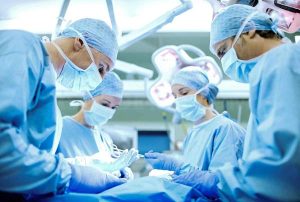
Laparotomy is a type of open abdominal surgery that is performed to examine the abdominal organs. Surgeons may use laparotomy surgery to diagnose and treat a variety of abdominal diseases.
In the following, we examine the types and applications of laparotomy, as well as what people should expect during and after laparotomy surgery.
What is laparotomy?
Laparotomy can help doctors diagnose some abdominal diseases. A laparotomy is a surgical procedure that involves making a large incision in the abdomen.
Doctors use laparotomy to examine the inside of the abdominal cavity to diagnose or treat abdominal diseases.
Uses of laparotomy
Doctors may use laparotomy for a variety of reasons. This procedure can help them diagnose or treat abdominal conditions, such as:
Abdominal pain
Abdominal injury
Peritonitis is an inflammation of the inner lining of the abdomen
An organ was pierced in the abdomen
Abdominal infection
Internal bleeding
Spread of diseases such as cancer or endometriosis
Women may undergo laparotomy for hysterectomy or removal of the uterus, or removal of the ovaries or fallopian tubes.
Types of laparotomy
There are different types of incisions in laparotomy:
Midline: This incision goes through the middle of the abdomen. This is the standard incision for laparotomy. If people only need surgery in the upper part of their abdomen, this incision is not made along the entire length of the abdomen.
Supramedian: A supramedial incision is a vertical incision that reaches one side of the midline. This allows the surgeon to access the kidneys and adrenal glands.
Transverse: A transverse cut is a horizontal cut. Surgeons may use this incision because it can cause less damage to the nerves of the abdominal muscles and heal better.
Pfannenstiel incision: Surgeons may use a Pfannenstiel incision to access the pelvic area, such as for an emergency cesarean delivery.
Subcostal: A subcostal incision is a diagonal cut on one side of the upper abdomen. The surgeon may use a subcostal incision to access the gallbladder or liver on the right side or the spleen on the left side.
Rooftop incision: If the surgeon makes a subcostal incision on each side of the body, the incisions may meet in the middle to create a Rooftop incision.
What is a laparotomy?
Recovery after laparotomy surgery
Because people may undergo a laparotomy for different reasons, recovery time can vary significantly from person to person. Many other factors, including a person’s age and overall health, also determine how long it will take to recover.
People may take steps at home to rest and allow their bodies to heal. This includes:
Depending on the doctor’s advice, rest as much as possible
Continue the activity and perform any exercises prescribed by the doctor
If possible, get help from other people at home and with daily tasks
Follow all dietary instructions from your doctor
Taking medicine as prescribed by the doctor
Avoid any heavy lifting, including pulling or pushing, sexual activity, and swimming for 6 weeks
You will usually feel tired or lethargic during recovery as the body is recovering. You also experience a wide range of emotions and have trouble sleeping.
People in recovery may not be able to drive because they are allowing their body to heal or because of medications they are taking. A person can consult his doctor about this.
If you develop signs or symptoms of infection around the wound, it is important to contact your doctor as soon as possible. These may include:
Increased pain or sensitivity to touch
turning red
swelling
Discharge from the wound site
Fever or chills
Vomiting or nausea
People should seek medical help immediately if they experience symptoms of a blood clot, including:
Difficulty breathing
chest pain
Severe leg pain
People can follow the doctor’s instructions carefully and ensure that they have a final checkup at the end of the recovery period.
Laparotomy surgery
Laparoscopy and celiotomy
Celiotomy is another term for laparotomy, and professionals may use these terms interchangeably.
Laparoscopy is a surgery in which the surgeon makes one or more small incisions in the abdomen. Then a small metal tube with a light and a camera on one end—called a laparoscope—is inserted into the abdomen through one of these incisions to examine the area. They can also insert other surgical instruments through other incisions.
Laparoscopy has a shorter recovery time than laparotomy due to smaller incisions. The decision to use laparotomy or laparoscopy depends on the type of surgery, the surgeon’s experience with each technique, and the individual’s overall health.
